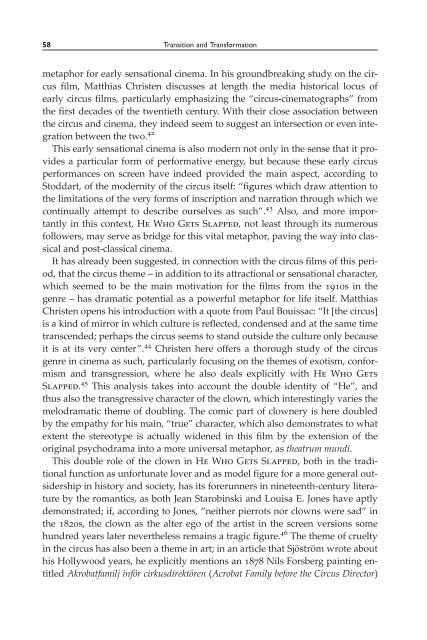FILM FILM - University of Macau Library
FILM FILM - University of Macau Library
FILM FILM - University of Macau Library
Create successful ePaper yourself
Turn your PDF publications into a flip-book with our unique Google optimized e-Paper software.
58 Transition and Transformation<br />
metaphor for early sensational cinema. In his groundbreaking study on the circus<br />
film, Matthias Christen discusses at length the media historical locus <strong>of</strong><br />
early circus films, particularly emphasizing the “circus-cinematographs” from<br />
the first decades <strong>of</strong> the twentieth century. With their close association between<br />
the circus and cinema, they indeed seem to suggest an intersection or even integration<br />
between the two. 42<br />
This early sensational cinema is also modern not only in the sense that it provides<br />
a particular form <strong>of</strong> performative energy, but because these early circus<br />
performances on screen have indeed provided the main aspect, according to<br />
Stoddart, <strong>of</strong> the modernity <strong>of</strong> the circus itself: “figures which draw attention to<br />
the limitations <strong>of</strong> the very forms <strong>of</strong> inscription and narration through which we<br />
continually attempt to describe ourselves as such”. 43 Also, and more importantly<br />
in this context, He Who Gets Slapped, not least through its numerous<br />
followers, may serve as bridge for this vital metaphor, paving the way into classical<br />
and post-classical cinema.<br />
It has already been suggested, in connection with the circus films <strong>of</strong> this period,<br />
that the circus theme – in addition to its attractional or sensational character,<br />
which seemed to be the main motivation for the films from the 1910s in the<br />
genre – has dramatic potential as a powerful metaphor for life itself. Matthias<br />
Christen opens his introduction with a quote from Paul Bouissac: “It [the circus]<br />
is a kind <strong>of</strong> mirror in which culture is reflected, condensed and at the same time<br />
transcended; perhaps the circus seems to stand outside the culture only because<br />
it is at its very center”. 44 Christen here <strong>of</strong>fers a thorough study <strong>of</strong> the circus<br />
genre in cinema as such, particularly focusing on the themes <strong>of</strong> exotism, conformism<br />
and transgression, where he also deals explicitly with He Who Gets<br />
Slapped. 45 This analysis takes into account the double identity <strong>of</strong> “He”, and<br />
thus also the transgressive character <strong>of</strong> the clown, which interestingly varies the<br />
melodramatic theme <strong>of</strong> doubling. The comic part <strong>of</strong> clownery is here doubled<br />
by the empathy for his main, “true” character, which also demonstrates to what<br />
extent the stereotype is actually widened in this film by the extension <strong>of</strong> the<br />
original psychodrama into a more universal metaphor, as theatrum mundi.<br />
This double role <strong>of</strong> the clown in He Who Gets Slapped, both in the traditional<br />
function as unfortunate lover and as model figure for a more general outsidership<br />
in history and society, has its forerunners in nineteenth-century literature<br />
by the romantics, as both Jean Starobinski and Louisa E. Jones have aptly<br />
demonstrated; if, according to Jones, “neither pierrots nor clowns were sad” in<br />
the 1820s, the clown as the alter ego <strong>of</strong> the artist in the screen versions some<br />
hundred years later nevertheless remains a tragic figure. 46 The theme <strong>of</strong> cruelty<br />
in the circus has also been a theme in art; in an article that Sjöström wrote about<br />
his Hollywood years, he explicitly mentions an 1878 Nils Forsberg painting entitled<br />
Akrobatfamilj inför cirkusdirektören (Acrobat Family before the Circus Director)

















